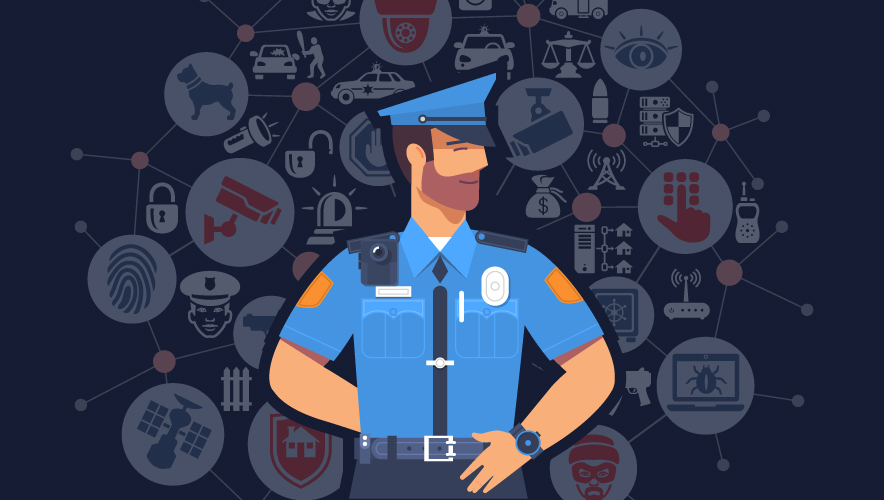
The collaboration of law enforcement applications and IoT necessitates the active operation of smart devices in public places and society in general. This ensures the government’s strict adherence to the rules and guidelines. The following are a few examples of Internet of Things (IoT) applications in law enforcement among citizens of any country or state:
Table of Contents
IoT Law Enforcement Applications
Sensors for traffic lights to help prevent accidents on the road
IoT can be used to control and manage traffic. The government installs sensors that detect movement on the streets and send data to police-run command centers. This assists traffic officers in keeping traffic under control and preventing serious accidents. The sensors detect the density of traffic on streets and highways, which controls when traffic lights are turned off.
IoT also aids in the provision of real-time traffic updates, allowing drivers to switch lanes and paths to save time.
Officer and government official wearables
Smartwatches can be provided by the government to government officials. These watches constantly manage information and keep track of their schedule. These watches also monitor pulse rate and send an alert in the event of an emergency. The government can provide new officers with reality aids that allow them to experience the stimuli of dangerous situations such as hijackings, robberies, and murder. Sensors on watches monitor their sleep patterns, body weight, daily steps, and other data.
Border patrol drones
Smart border protection is currently being used to protect borders from afar in Western and European countries. Smart border protection entails the use of drones to closely monitor the situation at the country’s borderline. In the event of a threat, the drones send alerts to military officials, who take appropriate action.
IoT in the courtroom
In recent years, IoT has aided in the resolution of murders and the reduction of crime rates. IoT devices throughout the city are storing valuable data that can be used as evidence to help catch a criminal. The data collected by IoT devices in the vicinity of criminals is used as a defense. Courts are gradually adapting to IoT technology.
Law enforcement
IoT devices assist officers by providing information about a criminal and assisting them in locating the criminal. Security systems and alarms throughout the city provide police officers with accurate and up-to-date information about the crime situation in the area, and officers can quickly find the criminal records of any citizen via the internet. In this way, IoT is assisting in the reduction of crime rates all over the world.
Using IoT to maintain law and order
IoT also aids in the upkeep of law and order in the city. On the street, IoT-enabled sensors detect whether or not a person is wearing a helmet. These sensors detect fast vehicles and send notifications to both the drivers and the traffic police.
Crime detection
The government can deploy IoT sensors and devices throughout the city. This aids in the identification of criminals and also tracks their movements. Security alarms, sensors, and systems can notify the police of any criminal activity in the city.
Evidence gathering
The main goal of IoT is to constantly collect data and transmit it via a network of devices. This feature of IoT is extremely useful for gathering evidence from a crime scene.
Data stored in devices such as smartphones, watches, and tablets can be accessed and stored as evidence by law enforcement.
Public cameras and WiFi networks also store a large amount of user information, which can be accessed by the government to recover criminal information.
Internet of Things firearms
A smart gun can only be used by legal adults who have a gun license. Because the biometrics on the guns check for authorization before allowing the gun to be used.
IoT firearms record the exact location of the shots fired as well as the subsequent events.
In high-pressure situations, IoT assists in automatically turning on the body camera.
Unidentified automobiles
Drones provide a new form of surveillance and can monitor areas where security personnel are not present. Drones and alarms raise alerts in the event of suspicious activity, send location information, and track criminals.
Intelligent Vehicles
Police officers’ smart vehicles are outfitted with a variety of features. These are equipped with cameras and voice recorders to capture details of any event. The cars are outfitted with computers that are linked to the internet and provide real-time information on the location and activity of criminals. These vehicles can communicate with fire departments, ambulances, and trucks.
Crime prediction and prevention
Data collection and storage is essential component of an IoT system. This IoT property aids in the prevention and detection of crimes, allowing for early intervention. IoT, in conjunction with artificial intelligence (AI), aids in the prediction of crime. “Heat mapping” refers to systems that use data analytics to locate criminal hotspots and help officers understand where specific crimes occur frequently in a community.

